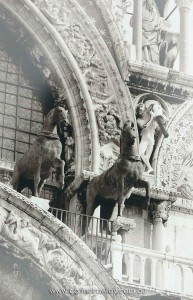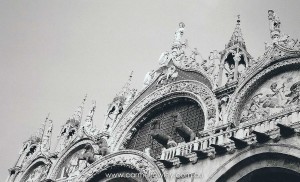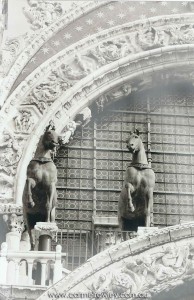THE HORSES OF SAINT MARK’S BASILICA
Carmel Rowley

What a busy few months, apart from working on my latest book I’ve been sorting through our house and having a thorough clean up. After living in one place for thirty years you end up finding so much stuff you’ve forgotten about! Last week when I tackled one of the spare rooms I came across about 25 photograph albums.
And what do you do when you find an old photograph album? You look through it don’t you? That was the end of my sorting for the day. Talk about Alice in Wonderland and falling down a rabbit hole. After lots of sighing over all the memories, our early horses and the photographs of us in our early twenties, I found a more recent album. This album was nearly full of wonderful black and white photographs of a trip I did with a dear friend to Europe back in 2004.
One of the places we visited was Venice. Here I have to mention that I couldn’t resist including a mystery (set in Venice) in book 2 of The Daughters of the Wind series – Voices in the Wind. That I loved Venice is an understatement, to me the history seeped into my feet and travelled all the way up to my brain. The atmosphere completely encompassed me.
Amongst the photographs were several of the horses of Saint Mark’s Basilica so I decided to scan several before refreshing my memory about the horses.
It’s so interesting that I thought some of my readers may enjoy the horse’s story.
The Horses of Saint Mark’s Basilica
From Wikipedia, the free encyclopedia
http://en.wikipedia.org/wiki/Horses_of_Saint_Mark
The Horses of Saint Mark, also known as the Triumphal Quadriga, is a set of bronze statues of four horses, originally part of a monument depicting a quadriga (a four-horse carriage used for chariot racing) The horses were placed on the facade, on the loggia above the porch, of St Mark’s Basilica in Venice, northern Italy after the sack of Constantinople in 1204. They remained there until looted by Napoleon in 1797 but were returned in 1815. The sculptures have been removed from the facade and placed in the interior of St. Mark’s for conservation purposes, with replicas in their position on the loggia.
The sculptures date from classical antiquity and have been attributed to the 4th century BC Greek sculptor Lysippos, though this has not been widely accepted. Although called bronze, analysis suggests that as they are at least 96.67% copper, they should be seen as an impure copper rather than bronze. The high tin content increased the casting temperature to 1200–1300 °C. The high purity copper was chosen to give a more satisfactory mercury gilding. Given current knowledge of ancient technology, this method of manufacture suggests a Roman rather than a Hellenistic origin.
It is certain that the horses, along with the quadriga with which they were depicted were long displayed at the Hippodrome of Constantinople; they may be the “four gilt horses that stand above the Hippodrome” that “came from the island of Chios under Theodosius II” mentioned in the 8th- or early 9th-century Parastaseis syntomoi chronikai.
They were still there in 1204, when they were looted by Venetian forces as part of the sack of the capital of the Byzantine Empire in the Fourth Crusade. The collars on the four horses were added in 1204 to obscure where the animals heads had been severed to allow them to be transported from Constantinople to Venice. Shortly after the Fourth Crusade, Doge Enrico Dandolo sent the horses to Venice, where they were installed on the terrace of the façade of St. Mark’s Basilica in 1254. Petrarch admired them there.
In 1797, Napoleon had the horses forcibly removed from the basilica and carried off to Paris, where they were used in the design of the Arc de Triomphe du Carrousel together with a quadriga.
In 1815 the horses were returned to Venice by Captain Dumaresq. He had fought at the Battle of Waterloo and was with the allied forces in Paris where he was selected, by the Emperor of Austria, to take the horses down from the Arc de Triomphe and return them to their original place at St Mark’s in Venice. For the skilful manner in which he performed this work the Emperor gave him a gold snuff box with his initials in diamonds on the lid.
Conservation – restoration of the Horses of Saint Mark.
The horses remained in place over St. Marks until the early 1980s, when the ongoing damage from growing air pollution forced their replacement with exact copies. Since then, the originals have been on display just inside the basilica.
It is rather from a vague tradition and the peculiar elegance, and chasteness of the design than upon any historical evidence that these horses are attributed to the statuary of Alexander. We are told that they were carried from Greece to Rome in the reign of Nero from Rome to Constantinople after the decision of the empire and from there to Venice during the crusades. The history of their subsequent adventures is connected with the history of Europe and is known to all! Their attitude is easy, dignified and composed, their gait slow yet spirited as if they were moving in a triumphant procession and presuming that they are the work of Lysippus our imagination would fondly suggest that they were designed by that artist to adorn the victories of the Conqueror of the world.
From Wikipedia, the free encyclopedia
http://en.wikipedia.org/wiki/Horses_of_Saint_Mark
Buy Carmel Rowley’s books online: www.carmelrowley.com.au
Photographs Carmel Rowley


2 Responses
Robert Brett
Thank you Carmel for your blog.
You mention that “The horses (of St Marks) remained in place over St. Marks until the early 1980s”.
Do you have any ideas on how to learn the exact date the original equestrian statues were removed in the late 20th century?
You, Wikipedia and several other undocumented sources note that they were removed in the early 1980s while Rick Steves mentions they were removed in the “1970s”.
I first visited St Marks in 1981. I’d like to know if I witnessed the original equestrian statues on top of St Marks.
Robert Brett
Historian & World Traveler
Olympia, WA
RSBrett@GMail.com
Carmel
Hi Robert, Apologies for the slow reply life has been very hectic this year. It’s quite a while since my visit to Venice and I thought what I had written was correct but like yourself I do wonder if the the horses on St marks are the original. We didn’t line up to go inside St Marks there was such a long wait but there is something in my memory that suggests the real horses were inside St Marks. Don’t take this as fact as you may have visited inside. Sorry to be so unhelpful. Kindest regards Carmel